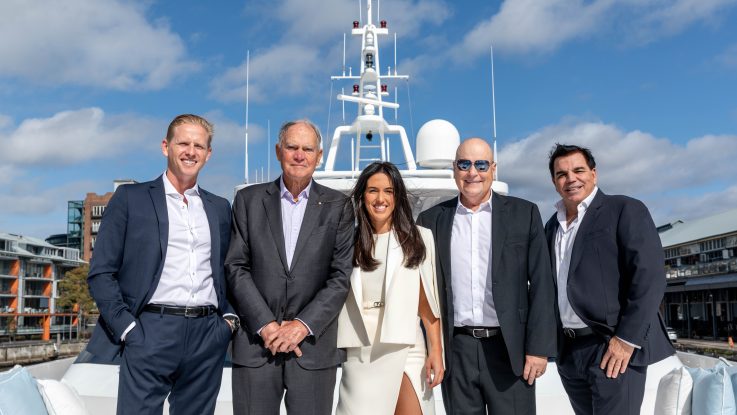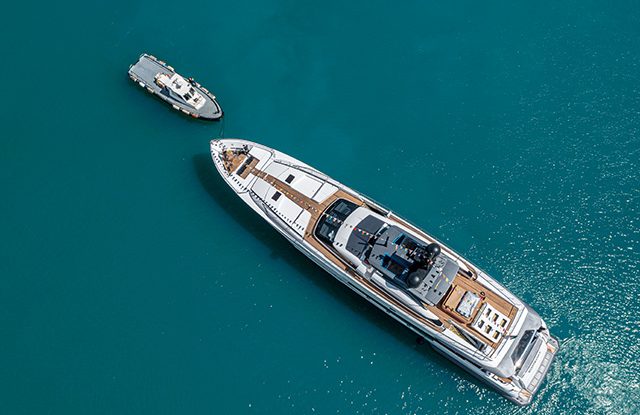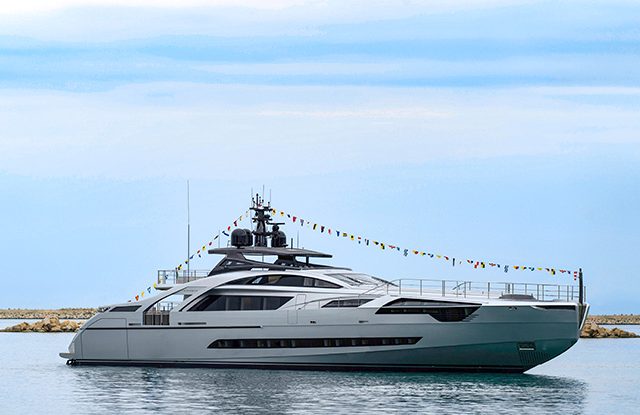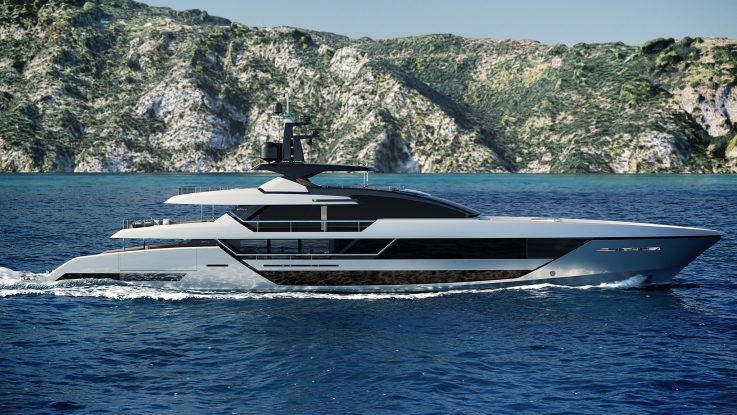2012: AZIMUT YACHTS LAUNCHES THE 55S, SETTING THE NEW BENCHMARK FOR INNOVATION, SPORTINESS, STYLE, AND COMFORT AT THE SEA
(Courtesy of Yacht and Boat)
Light and strong, thanks to carbon fibre used in bulkheads, flooring, engine-room structures, and cabin trays, streamlined and dynamic, thanks to a new leap forward in design, agile and speedy as a new idea, the 55S represents a revolution in the world of sport yachts.
You could start by describing the bow or the stern, but to talk about the 55S using commonplace terms would be doing it an injustice.
The 55S is something else.
Each part of the boat is intimately and conceptually linked with the others in a virtuous circle of cause and effect: spaces gained at the stern are reflected in the bow, while technological innovations make the owner’s life more pleasurable in every area of the boat. The 55S is a revolutionary. There nothing to do but follow it.
The change starts in the engine room.
Every revolution springs from an idea, and the idea here lies in the choice of engines: there are three on board the 55S, where as the more traditional formula calls for two.
A winning choice: at equal power, three engines consume less than two, weigh less than two, offer higher performance than two, and are more compact than two, particularly if, like those in the 55S, they employ the POD transmission and not one that uses an in-line axis.
As a result of this choice, it was possible to move the engine room back to the end of the stern, optimising each free centimetre, from the shaft to the propellers. In addition, thanks to the compactness of the engines, whose height has also been reduced, it was possible to design a garage that enables a Williams 285 tender to be brought on board and kept inside the boat without it disturbing the aesthetics or compactness of the stern platform.
First effect of the revolution: Opening up the cockpit area.
The crew cabin, which would normally be located in the cockpit are (now occupied by the engines and the garage), has been completely redesigned and moved to the bow. A single solution that has at least three benefits: first for the owner and his guests, who can enjoy the cockpit area in full freedom and complete privacy at any hour of the day or night. Second for the crew, who for their part can freely enter and leave their quarters via the bow, in an area usually less frequented by guests, especially at night. The third benefit is even greater in the true sense of the word – and has to do with the VIP cabin.
Second effect: The VIP cabin gains space.
In the 55S, the cabin dedicated to special guests, which in boats of this size is usually at the front of the bow, has been designed and located after the crew cabin. At this location, it enjoys an uncommon amount of space, since the yacht’s bulwarks are considerably closer together in the bow, whereas as in the VIP area, they are father apart and create spacious volume. The designers did not fail to take the opportunity to offer special guests maximum freedom and comfort of movement and to outfit the cabin with full height wardrobes, indicative of first-class on-board comfort.
Master effect: The owner is the new king.
The longitudinal distribution of spaces also works to the benefit of the owner, with a large master cabin that offers a place to relax not just during the evening, thanks to an extraordinary amount of natural light: light enters through windows on both sides, as well as through a transparent panel located above the vestibule.
The view is excellent as well: the sea performs a show just centimetres from the windows, ready to serenade the owners with an interplay of light and water One section of the windows on each side can be opened, enabling the owner to enjoy the smell of the sea and the sound of the gentle lapping of the water.
For added comfort during moments that are already naturally magical, two armchairs placed below the portside windows, along with a small table that can be converted into a vanity, invite contemplation and unforgettable breakfast.
The double bed can be raised with pistons, revealing an ample place to store empty luggage after having filled the wardrobes and lockers and used the spacious volume in a double cabinet hidden in the wall above the bed head.
The sunbathing area at the bow has been revolutionised.
The revolution continues: the volumes gained on the lower deck, which add to the comfort of owner and guests alike who enjoy full-height interiors, are also reflected on the main deck, laid out on a single level without steps. Thanks to this characteristic, the designers have been able to create an area of relaxation at the bow, with a sofa facing the direction of travel and a convenient passageway that separates it from sunbathing cushions, which in turn are ample enough to accommodate three people. These are the types of features that are found only on boats of 75 feet or more.
Duplicating effect: two swimming platforms instead of one
Ideas call for more ideas. The stern area on the 55S is one example of this. Take the swimming platform. Served by two ladders going up to the cockpit is a swimming platform that could hold a sunbed and is perfect for diving and bathing, either in the sun or the sea. Is something hiding? In fact, yes: it’s hiding another one.
Operated by electric controls, the large door to the garage opens and, being directly connected with the swimming platform to form a single L shape, tilts it toward the sea.
At this point, the attention switches to the garage door, which continues to open, revealing itself to be lined with teak on the inside. Putting teak on the inside wall of a garage? A few more seconds, and you understand why.
The garage door opens up fully into a horizontal position: the sea now laps against a new swimming platform in teak, almost twice as big as before. But there’s more.
Another command, and the platform tilts further to allow the hauling or launching of the tender.
Docking to applause
The backs of the two single sport seats, covered in white leather, indicate the wheelhouse area, located to the right.
Just two handles run the three engines. The underlying idea is to simplify each task for the owner.
Two handles run three engines, while a control unit automatically compensates for small differences, if any, in the power supplied to the engines. If the differences in power exceed a certain threshold, the control unit recognises these as being desired and does not make any corrections. Perhaps the most important control, however, is the joystick, which makes docking manoeuvres “elementary”.
One of the benefits of navigating with three engines consists of the considerable distance between the two outer propellers.
This distance makes lateral approaches easier and very precise. While one propeller pushes, the other pulls, and the one in middle remains (automatically) in neutral. Everything happens automatically: the owner simply needs to move the joystick to the right if he wants to approach the dock on that side.
This may well generate admiring looks from land crews.
Prompt responsiveness in acceleration and turning.
Each of the three Volvo Penta engines has twin counter rotating propellers placed in the front position. Direction is an effect of the thrust of the three engines, which rotate on their axis and control the speed of the respective propellers in order to support of the commands given by the pilot. The triple engines have two effects: a very tight turning radius, including at high speeds (an added safety feature while navigating), and a clearly perceptible feeling of acceleration. The brilliance of the engines on the 55S and a top speed of 37 knots speak right to the heart of those who like thrills, but quite often, even the most sporting owner likes to leave the wheel in order to relax in a sophisticated, comfortable environment with his affections and his friends. A few minutes, a couple of hours, or half a day at anchor, then off again, planning, to a new appointment with the greatest of emotions.





